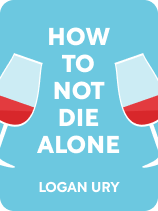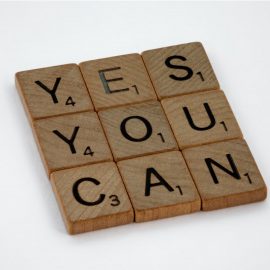

This article is an excerpt from the Shortform book guide to "How to Not Die Alone" by Logan Ury. Shortform has the world's best summaries and analyses of books you should be reading.
Like this article? Sign up for a free trial here.
What is Logan Ury’s How to Not Die Alone about? What is the key message to take away from the book?
Logan Ury is a behavioral scientist, dating coach, and Director of Relationship Science at the dating app Hinge. In her book How to Not Die Alone, Ury presents a science-backed approach to finding the true love you’ve always wanted so you can do exactly what the title says.
Below is a brief overview of Logan Ury’s book How to Not Die Alone: The Surprising Science That Will Help You Find Love.
How to Not Die Alone: The Surprising Science That Will Help You Find Love
In her book How to Not Die Alone, Logan Ury contends that the first step to finding your true love is to understand your “dating tendency” or pattern. According to Ury, there are three unhelpful dating patterns that people fall into when looking for love: maximizers (or optimizers), romanticizers (or fairytale chasers), and hesitaters (or delayers). In this section, you’ll learn about each pattern, why it leads to unhappiness—and how to prevent your own pattern from sabotaging your dating life.
How Maximizers Behave
The first dating pattern is the maximizer, or optimizer. Ury explains that if you’re an optimizer, you want to be 100% sure you’ve made the right decision—so you do as much research as possible before choosing anything.
Unfortunately, Ury explains, optimizing often leads to unhappiness—mainly because it causes so much stress. You’ll date several people but struggle to commit to someone because you’re worried about missing out on someone better. And even if you do commit, you’ll torture yourself wondering if you made the right decision.
What to do instead: Ury recommends that optimizers learn to “satisfice: ” Find and commit to someone who meets your standards, even if they aren’t perfect. Doing so will make you happier for two main reasons: First, you’ll mitigate the stress of optimizing during the selection process because you’ll have clear standards by which to evaluate your choices. Second, by fully committing to your partner, you’ll avoid the stress of wondering whether you made the right choice after you’ve already selected someone because of a neurological phenomenon known as rationalization: If you finalize a decision (like selecting a partner), your brain will convince you that you’ve made the right choice.
To satisfice effectively when dating, Ury recommends using an algorithm: Explore without committing for the first 37% of your dating life, then commit to the next top pick you see.
To do so, first find your Exploration Limit Age: [(Age You Want to Get Married – Age You Started Dating) x .37] + (Age You Started Dating). For example, if you want to get married at 28 and you started dating at 18, your exploration limit age would be 21.7. Once you reach your exploration limit age, review your partners and determine which partner you liked the best. (If you’ve already passed that age, review the partners you dated before you reached that age.) Commit to the next person you date whom you like better than your favorite ex-partner.
By following this formula, Ury explains, you’ll date enough people to know what kind of partner you want—but you won’t date so long that you miss out on all the good potential partners before they leave the dating pool.
How Romanticizers Behave
The second dating pattern is the romanticizer, or a fairytale chaser. Ury explains that if you’re a fairytale chaser, you approach dating with an attitude that your relationship happiness depends on whom you’re dating.
Ury explains that approaching dating with this attitude also causes problems. Notably, fairytale chasers tend to envision their ideal soulmate—so when dating, they may overlook great candidates who don’t exactly match this ideal. Additionally, fairytale chasers believe that finding a good partner guarantees a blissful, problem-free relationship. So when their relationship inevitably hits a rough patch, they assume they’re with the wrong person and start to look for someone else, beginning the cycle anew.
What to do instead: If you’re a fairytale chaser, Ury recommends that you shift your attitude and develop a mindset that a happy relationship depends on how hard you work at it. With this mindset, you’ll temper your expectations regarding what your soulmate is like and thus grow more open to dating great people who don’t match your ideal. And you’ll realize that all relationships have some issues, so you’ll be willing to work on them when they inevitably arise.
How Hesitaters Behave
The third dating pattern is the hesitater, or the delayer. Ury explains that if you’re a delayer, you want to date but don’t take any steps toward finding a long-term partner because you don’t feel confident dating. Instead, you’ll repeatedly insist that you’ll start dating “when X happens”—whether X is financial stability or a better haircut.
However, Ury contends that delayers fare poorly in the long run because they forfeit two big learning opportunities. First, dating involves a particular skill set—such as an ability to communicate well. If you delay dating, you never develop these skills, so you never learn how to date effectively. Second, you can only learn what you prefer in a long-term partner by dating several different people: For example, someone intrigued by non-monogamy may discover that they don’t enjoy it as much as they expected. If you don’t date, you don’t discover what you actually want.
So if you’re a delayer, Ury recommends that you just start dating. This may be difficult since humans suffer from what behavioral scientists call an “intention-action gap”—a disconnect between what we want to do and what we do in reality. One main strategy to overcome this disconnect is to set a deadline to start dating—one that’s short enough to spur you into action but far enough away that you can prepare. Ury recommends setting a deadline three weeks from today.
Understand Your Attachment Style
In addition to understanding your dating patterns, Ury recommends learning your attachment style as it might also be sabotaging your attempts to find true love.
Ury explains that people fall into one of three attachment styles, which are the beliefs and behaviors that determine how you function in intimate relationships. Anxious attachers are preoccupied with making their relationship solid and constantly seek reassurance from their partner. Avoidant attachers don’t trust that others can meet their desire for intimacy, so they strive to maintain emotional distance from their partner. Secure attachers are nurturing, responsive, and comfortable with intimacy.
If you’re an anxious or avoidant attacher, Ury recommends two strategies to ensure that your attachment style doesn’t sabotage your dating life. First, date secure attachers, who are better able to meet your intimacy needs. Second, practice managing your knee-jerk reactions in pursuit of happiness. Instead of panicking, anxious attachers should learn productive ways to soothe their nerves when their partners don’t provide immediate reassurance. Instead of withdrawing, avoidant attachers should learn to communicate when they want emotional distance.
Find Your Ideal Partner
Now that you’ve learned about what kind of dater you are, it’s time for the next step: finding a good partner. In this section, you’ll first learn what kind of partner you should be looking for. Then, you’ll discover how to meet good people—both on- and offline. Finally, you’ll learn how to maximize your chances of finding a good relationship by learning how to date properly.
What You Should Be Looking For
According to Ury, many people struggle to look for the right qualities in a long-term partner. This happens for two reasons. First, we have a tendency to prioritize immediate benefits over future benefits. Second, we tend to assume that whatever gets our attention is more important than what doesn’t. When dating, these tendencies lead us to prioritize qualities that don’t indicate long-term compatibility.
For example, you might look for an extremely good-looking person because you want to find them hot and their looks grab your attention. But good looks and lust both fade—so how physically attracted you are to someone isn’t a good measure of compatibility.
So what should you be looking for? Instead of putting superficial qualities like looks at the top of your list, Ury recommends focusing on the following criteria for long-term relationship success:
1) Look for someone who is nice and even-tempered—both qualities that researchers have found are highly predictive of long-term relationship success. Nice people treat people who can’t help them (like service workers) well; even-tempered people respond with grace even when they’re stressed.
2) Look for someone with whom you can get through the hard times. Such a person will have a growth mindset—a belief that people can learn and improve—so they’re prepared to fight through challenges, both in your relationship and in their own lives.
This includes being good at fighting with you: Your arguments should be productive and not instill fears about the health of your relationship. Relationship researchers contend that someone who’s good at fighting well will have two main characteristics. First, they’ll find a healthy way of dealing with the unsolvable conflicts that make up most couples’ arguments, like how often one partner wants to spend time with their friends. Second, they’ll actively try to defuse the tension during fights, such as by apologizing when they’re wrong.
3) Look for someone who has a complementary personality. Many of us assume we’ll be happy with someone just like us—but research doesn’t support this finding. Rather, find someone who helps you be your best self. For example, if you’re set in your ways, someone who’s adventurous might pull you out of your shell and help you try new things.
How to Meet Good People
Once you know what kind of partner you want, how do you actually find them? Ury recommends several strategies for meeting people—both offline and online.
How to Meet People Offline
To meet people offline, Ury recommends two strategies. First, go to events. Optimize your chances of meeting someone great by attending events that facilitate connections and that you’ll likely enjoy: You’ll have a good time even if you don’t meet any potential partners. Consider local meetups, volunteering, or athletic leagues.
You should also connect with people at the event. Start by going alone, since people are more comfortable talking to people who are by themselves than big groups. Introduce yourself to at least one person; if you’re shy, practice first by introducing yourself to people you’re not attracted to. Be friendly during your conversation—and if you find someone you like, ask for their contact information so that you can follow up later.
Ury’s second strategy is to go on blind dates set up by people you know. To do this successfully, first ask your connections for help, describe the type of person you’re looking for, and send them some good photos of you. Then, actually go on the date—and always provide feedback. They’ll appreciate your gratitude if it was a great date. Otherwise, telling them what you liked and what you didn’t will help them provide you with better options next time or allow them to gently point out if you’re being unreasonable.
How to Meet People Online
To meet someone online, Ury recommends three strategies for improving your odds: Keep an open mind, limit the number of people you date at once, and present yourself well.
First, Ury recommends that you keep an open mind when swiping: Reconsider and readjust your filters, and don’t reject someone based on a single trait. Why? Ury explains that apps encourage you to judge people based on limited information and arbitrary criteria. But in real life, we constantly meet people who challenge our initial assumptions about what we want in a partner. For example, you might decide you never want to date a vegetarian because you think they’re all hippies, but then you meet someone great who’s a vegetarian for health reasons. So by judging people too harshly, you may be filtering out a potentially great partner.
Second, Ury recommends that you limit the number of people you date simultaneously. If you date too many people at once, you won’t get to know any of them on a deeper level. But if you limit the number of people you date, you maximize your chances of getting to know someone well and thus connecting with them romantically.
Third, Ury recommends that you present yourself well. To do so, pick great photos that clearly represent what you look like today. For best results, send a selection of photographs to your friends, since your friends are typically better than you are at choosing which photos you look best in. Additionally, create a profile that invites conversation by providing specific details about your life that someone can easily comment on. For example, instead of writing, “I like books,” list your top five books.
How to Date Properly
Once you meet someone promising, how do you maximize your chances of discovering whether they’re the right person for you? Ury recommends that you do three things: Manage your expectations, design a great first date, and always go on the second date.
First, Ury suggests that you set realistic, but positive, expectations. You must be realistic because too many of us expect too much from our first date. We want to feel an instant connection, but such a connection is rare—partly because we tend to like something (or someone) more the more we encounter it. So don’t discount your date just because you don’t feel an instant connection with them; remember that feelings can grow.
That said, don’t be a downer—having a positive attitude is critical to the success of your date. Experiments have found that when we expect to be lucky, we’re better able to notice opportunities we can take advantage of. Similarly, if you expect the date to go well, you’ll be better able to notice your date’s positive qualities and will have a better time.
Second, Ury suggests that you design a great first date. When dating, your goal is to figure out how a person makes you feel—so it’s essential to go on dates that promote natural connections (instead of ones that encourage you to quiz each other). Try doing something creative together: You’ll have fun and might learn whether your date has the qualities you’re looking for. For example, if you take a pottery class and your date can’t follow the instructor, do they continue trying anyway (indicating a growth mindset)?
Third, Ury suggests that you always go on the second date. We’re primed to judge our dates harshly, partly because we’ve evolved to pay more attention to negative things, so we tend to focus on their flaws rather than their strengths. By creating a rule that you’ll always go on a second date, you allow yourself more time to see if a connection will develop and to find more positive qualities that might outweigh the flaws.
Work on Your Relationship
Now that you’ve learned how to meet great people and date so that you find a connection, how can you ensure that you have a happy, long-term relationship? In this section, you’ll first learn how to move through each stage of your relationship effectively to maximize your chances of happiness. Then, you’ll learn how to ensure you remain happy with your relationship—even as you both change and grow.
How to Decide Well at Turning Points in the Relationship
As Ury points out, relationships are full of decisions—from deciding whether to date officially to deciding whether to get married. Behavioral scientists refer to these landmark changes as decision points—moments that interrupt your routine and make you reconsider whether you’re on the right track.
According to Ury, there are two ways you can approach these decision points. You might reactively “slide” into the next stage without giving it serious consideration. Alternatively, you might think more deeply and actively choose, or “decide” to move into the next stage. Ury recommends you become a decider because they tend to have happier marriages. Specifically, you should make a decision at the following transitions: defining the relationship, cohabitating, and getting married.
How to Navigate Defining the Relationship
How can you ensure that you actively choose to define the relationship? Ury recommends that you first discuss your expectations for the relationship when you want to be exclusive. Exposing your feelings can be scary, but making your wishes clear will save you potential heartbreak long-term (if your desired partner doesn’t see you as long-term material). And even if your conversation doesn’t turn out the way you hoped, you’ll have more information to help guide you on your partner search—whether that means continuing to date this person or moving on to someone else.
How to Navigate Deciding to Cohabitate
How can you ensure that you actively choose to cohabitate? Ury recommends that you seriously evaluate whether you want to cohabitate. People who move in together pre-marriage are more likely to get divorced, which relationship researchers theorize is because cohabitation makes splitting up harder: When a breakup involves someone moving out, it’s easier to ignore the nagging feeling in the back of your mind that you’re with the wrong person and slide into marriage instead.
To minimize the chances that cohabitating jeopardizes your relationship, Ury recommends that you discuss your expectations about the future with your partner to ensure that you’re in sync. Additionally, discuss any anxieties you may have about cohabitating, like a worry that you won’t get enough alone time, so that you can work through them and set up a plan to deal with them prior to moving in.
How to Navigate Deciding to Marry
How can you ensure that you actively choose to get married? Ury recommends that you critically examine your needs and wants prior to getting married. Humans are subject to a consensus bias: We assume that other people want and believe in the same things we do. But this bias is dangerous. It can lead us to marry people without discussing important topics because we assume they agree with us—then later end up being unpleasantly surprised. For example, you might assume that your partner wants to stay home after you have kids, only to learn that they want you to stay home instead.
To avoid the marital dissatisfaction that can stem from the false-consensus effect, Ury recommends sharing both your history and your expectations with your partner. Once you’ve determined that your partner is someone who can support you and improve your life long-term, sit down with your partner to discuss three important topics.
Dedicate one night to learning about each other’s history, like how your parents dealt with serious topics or important childhood events. Dedicate a second night to discussing how you are now: Talk about how you could improve the relationship and open up about your current financial situation. Finally, dedicate a third night to discussing your future expectations, like your long-term career goals and how you want to raise your children. Ury explains that it’s OK if your expectations don’t exactly align, as long as you can talk through and have a plan for dealing with them.
How to Stay Happy Long-Term
Now that you’ve found someone with whom you want to build a life, how do you ensure that your partnership remains happy? Ury contends that the key is to build a relationship that can grow with you. She explains that most people recognize that they’ve changed a lot in the past, but they don’t expect to change a lot in the future. But in reality, you (and your partner) will probably change just as much in the future as you did in the past. Therefore, it’s critical to ensure that your relationship evolves, too.
Ury recommends two techniques for ensuring that your relationship adapts to your changing needs as the years go by. First, write a relationship agreement, or a “contract.” In this agreement, articulate your relationship values and how you’ll express them. Revisit this agreement regularly at intervals that work for you—whether that’s yearly or biannually—to review and update it as needed. By doing so, you’ll deal with potential issues early instead of letting them fester and damage your relationship long-term.
For example, if you value time together, you might initially write that you’ll spend 12 hours one-on-one each week. Once you have kids, you may realize that you regularly only spend 30 minutes together one-on-one and work on adding more couple time to your lives. By doing so, you maintain your connection instead of growing slowly distant and thus unhappy.
Second, Ury suggests scheduling a recurring, weekly state-of-the-union, or “check-in ritual.” This meeting is a safe space in which you can communicate things with your partner that might be otherwise uncomfortable or brushed aside. By doing so, you maintain your bond and ensure that small problems don’t blow up into bigger issues because you haven’t dealt with them. For example, you can express early on that you feel unappreciated when your partner doesn’t pitch in with household duties, instead of letting that disappointment sit without communicating it and feeling unappreciated by your partner in general. It’s critical that you actually schedule this ritual—if it’s already on your calendar and you don’t have to set up a time every week, you’re far more likely to have the meeting.
How to End Your Relationship
It’s great if you find someone you want to spend your life with—but what if you aren’t sure that this person is the one? In this section, you’ll first learn two major reasons you may struggle to end your relationship. Then, you’ll discover how to make that process as painless as possible—and how to recover from the heartbreak.
Why You Struggle to End Your Relationship
Ury explains that, in breakups, people often have one of two types of unhelpful tendencies. The first tendency is to drag out relationships they know aren’t working because they’ve already invested time into the relationship. But in doing so, they forfeit the time they could be spending building a better relationship with someone else.
The second tendency is to leave perfectly fine relationships because the initial high of a new relationship wears off. But in doing so, people forfeit the ability to learn how to be in relationships long-term.
How to End the Relationship
Once you’ve decided to end the relationship, how do you actually do it? Ury argues that the key is to make a plan, as research suggests that people are more likely to follow through on their goals if they make a plan for doing so.
First, plan what you’re going to say: Compassionately communicate that the relationship isn’t working, but don’t name specific reasons, as this will likely lead your soon-to-be ex to obsess over whatever you say. Second, schedule both the breakup and its immediate aftermath. Select a time to have this conversation that works for both your and their schedule. Allow yourself up to 90 minutes, but then have something else to do—like drinks with your best friend—so that you can avoid dragging out the breakup unnecessarily.
How to Recover From a Broken Heart
Whether you’re the dumper or the dumpee, breakups are painful. Ury argues that the key to recovering quickly is to frame the breakup positively by focusing on how it benefits your life. To do so, consider writing a breakup diary: Spend time listing both what’s good about the breakup and what was negative about the relationship. You might also start participating in activities you gave up on during the relationship so that you can focus on how the breakup adds to your life instead of on what it took away.

———End of Preview———
Like what you just read? Read the rest of the world's best book summary and analysis of Logan Ury's "How to Not Die Alone" at Shortform.
Here's what you'll find in our full How to Not Die Alone summary:
- A science-backed approach for finding the true love you’ve always wanted
- How your patterns may be sabotaging your quest for true love
- How to effectively navigate the twists and turns of a relationship






